The Artworks
Artist: Izzy/Jeni Nix
Artist: Laura Phillips
Artist: Iain Renton
Artist: Tricia Reust
Artist: Sharon Roberts
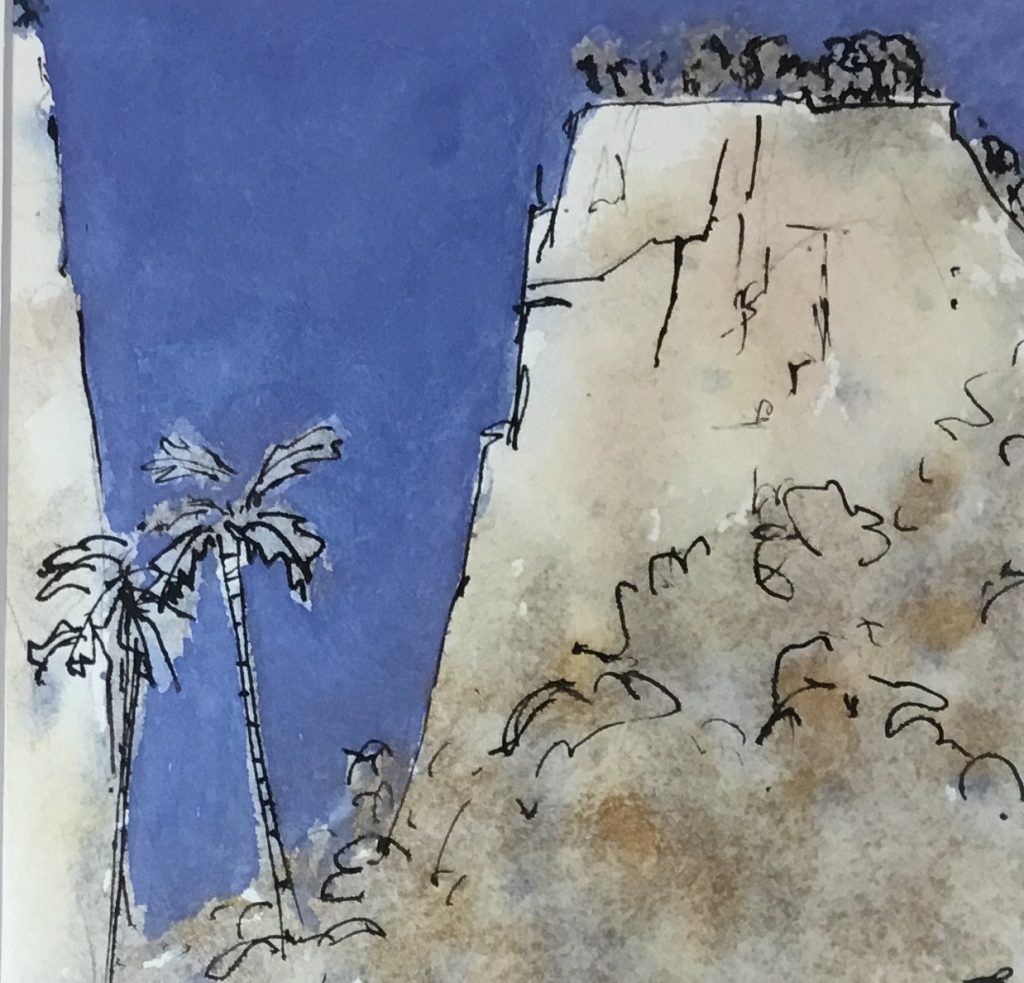
Artist: Dona Spencer
Artist: Touchstones Group (Kenmore Uniting Church)
Christianity and the Visual Arts
Catalogue Essay
The theme of ‘new life’ has encouraged the 21 artists of Visionaries who have contributed work for this exhibition to pursue a diversity of insights, ranging from their interpretation of the theme in biblical passages to the many ways that new life is viewed in the natural world and the expression of personal stories and experiences. These approaches are often linked through the choice of visual symbolism. Together with this diversity of approach to the theme is the diversity of media used.
While some works can be read and interpreted by the viewer almost at a glance others require a slow, contemplative approach to discover the layers of meaning in delicate visual line, colour and figures. Certain works are very contemporary in making statements about current issues in the community. There is work which refers to new growth after bush fires and other work which highlights the refugee experience. The explanation or story in the artists’ statements often sheds the light of extra meaning on what is before the eyes.
This is certainly an exhibition in which artists use a wide range of media. There are the works, large and small, in oil or acrylic on canvas, the works in water based media on paper, watercolour and gouache, several works using mixed media, paper weaving works, ceramics and waxed paper vessels, etching, and works using fabric and thread which are sometimes recycled from a previous use, glazes on timber, a piece of wire sculpture and photography. Sharon Roberts has chosen to use traditional pigments rather than new synthetic ones. It is an interesting and exciting exploration of the theme expressed in a wide range of ways. It celebrates ways in which new life regularly emerges across all of creation and also the new life which is God’s gift in Christ.
In this brief essay I aim to discuss firstly the work which makes direct reference to biblical stories, then the work which makes symbolic reference to these passages. I will then refer to the works which interpret the new life theme in relation to the natural world, to those works which make reference to the artist’s personal story of new life experience and then to the work which includes reference to issues of social responsibility to offer new and better life. Certainly some of the artists are interested in expressing more than one aspect of these approaches. Jennii Gould’s paper weaving works celebrate the victory of Christ’s cross in her use of colour and movement of line. Geraldine Wheeler’s “Rose Window: Four Resurrection Appearances” seeks to incorporate four of the biblical stories into one design, using the gouache stencil medium which resembles stained glass with its black paper lines. Joy Harris employs the Pentecost theme symbolically, while Kerry Holland has the theme of Visitation, Mary’s visit to Elizabeth when both are pregnant with Jesus and John (the Baptist) respectively and she thinks of the way they spent time together. Rosemary Hennii uses the theme of new covenant. From the Old Testament Jennifer Long draws upon the concept of “Exodus” for a diverse expression of work using etching and vessels and Mariangela Bonasia-Lewis goes back to the original Genesis story of creation.
Several of the artists employ other symbolic biblical references. Dianne Minnaar’s “Resurrection”, which is used for the poster, has the newly emerged butterfly as the symbol of Jesus’ resurrection and her other works, all of which employ a contemporary icon style, also use the symbolism of a natural object, a lily and a seed, as indeed did Jesus in parables. Marcellien Hunt uses both the white lily and the poppy with similar symbolic reference to the biblical story. In mediaeval manuscripts, e.g. the Book of Kells, a page with the Greek letters beginning the title, Christ, chi (X) and rho (P) or (Chr in English letters), is highly decorated before the passage in Matthew 1: 18ff which tells of the birth of Jesus. This has inspired me to use an Australian bush tree, a brachychiton, as symbolic of Advent in doing a chi-rho page design.
New Life is depicted through a range of images from the natural world in several works. Dona Spencer gives us “The Garden of Life” and Laura McDade has photographed three of her symbolic floral works for the seasons of spring, summer and autumn. The almond trees in flower by Murhaf Obeid are expressive of both the beauty of the flowers and the new life for refugees such as he has found in Australia. Juana Bernardo pictures the regrowth which regularly happens in the natural world as in new growth after the devastation of bush fires. Marion McConaghy’s “Malleolus Novellus” offers several images combined with levels of meaning, from elderly grandmother and new born child to new life in the vine seen in diverse ways across the natural world. Deb Mostert expresses the theme with a series of birds each of which has its contribution of life and purpose.
Many a gardener watches new leaves emerging in plants in pots or in the garden as suggested in my “New Leaf Emerging”.
Some artists have expressed very personal experiences as has Barb Niczynski as she found her way back to doing art with fabric after major problems with her sight, an eye condition which prevents her doing her usual careful, detailed drawings. Sue Oliver’s works also arise from her experience of major health problems, using tiny pieces of knitting or crochet done by her grandmother to symbolise the tiny parts of the human body, the work expressing both brokenness and healing. Gregg Nowell expresses the need for and experience of renewal by depicting various aspects of nature. Many of the works invite the empathy of the viewer for the artist and the making of links with the viewer’s own experience. Sharon Roberts challenges the viewer in “Choose”, both in interpreting her painting and in life’s choices.
While Murhaf Obeid’s work expresses the refugee experience as, for the fortunate ones, the offer of a new life, Tricia Reust’s series of three works, one pastel and two mixed media on canvas, express how she sees the need for people to open themselves, crack open the jar, to see and respond to the needs of the world and its peoples.
The exhibition also includes three dimensional works, Jennifer Long’s “Exodus” , Kerry Holland’s “Visitation III” and Tanya Van Reijsen’s “Shells of Protection” which is a sculpture piece using wire and eggshells. Shells protect the life within. “The Rebirth Coat” by Barb Niczynski, when around the shoulders, is also three dimensional. There is also Jennii Gould’s artist’s book.
While visual art can be viewed in terms of the medium and the artist’s skill in its use, to make works of visual art and then to view and study them has other depth dimensions, the artist’s thinking, the layers of media and meaning in the work itself and the way that the viewer studies, contemplates and enters into the experience of looking, feeling and understanding.
The artists of Visionaries once again thank the staff of ACU for the invitation to contribute to the life of the university through this exhibition, especially during these unusual and more difficult times for all. The exhibition cancelled in 2020 finds new life in 2021.
Geraldine Wheeler, co-ordinator of Visionaries
Advent to Christmas Art Exhibition 2018
by members of Visionaries
Vera Wade Gallery
St. Andrew’s Uniting Church
Cnr Ann and Creek Streets, Brisbane City
Artists: Jennii Gould, Marcelien Hunt, Joanne Lane, Marion McConaghy, Sue Mansill, Graham Moss, Susan Pietsch, Sharon Roberts,
Wendi Sargeant, Cees Sliedrecht, Geraldine Wheeler.
Open weekdays, 11 am to 2 pm, except public holidays
November 26th to January 4th
Blessings and Grace
The works of visual art in this exhibition reflect human experience of the gifts of God, “blessings” and “grace” , some reflecting more generally on the experience, others making particular reference to this time of year, Advent to Christmas, and the biblical story which is central to these celebrations. In some works the artist aims to express theological concepts visually.
Children’s book author and illustrator, Jennii Gould, offers a series to picture the steps of experiencing God’s gifts, through forgiveness, to healing, redemption and being crowned, drawing upon the verses of Psalm 103:3-4. The tiny child suggests the human self in these experiences. In three of Marion McConaghy’s works we also find the child, “…for theirs is the Kingdom of Heaven”, drawing upon the words of Jesus to the disapproving disciples as he blessed the children (Matthew 19:13-15). The child sees the beauty in nature as the gift of God and the pictures capture the child’s sense of wonder in both what is seen in nature and the working of modern technology. It is fitting to see in these works an emphasis upon the child when the broad community at this time also involves children widely in Christmas celebrations, the celebration of the Christ Child.
A corner of the Vera Wade Gallery has been set up as a children’s corner with a decorated Christmas tree and toys. Sue Mansill’s The Gospel Tree makes reference to Christmas trees, those set up in public places such as the Brisbane city square and those in private homes. She includes an anonymous poem she found on the internet, “The Gospel Tree” which suggests meanings for the tree.
The beauty of the natural world evokes many different responses and meanings. The photographs of Joanne Lane, a professional photographer who regularly works with overseas aid organisations and travels widely, are of flowers which contain several references and meanings for her, sometimes accompanied by the words of poets. Poppies and sunflowers can be seen as gifts, colours, of blessing and seeds of hope.
The role of Mary, mother of Jesus, is brought to our eyes in a range of different ways. Marcelien Hunt’s A World in Waiting pictures the waiting of the pregnant mother, uncertain but trusting in God’s purpose. Wendi Sargeant’s Theotokos is a visual meditation upon the role of Mary, the bearer of God (the Greek word is often translated as Mother of God), using curving, circular lines to enfold mother and child, and in A Visitation Fragment, Geraldine Wheeler depicts a woman reflecting on a fragment of relief sculpture of Mary’s visit to her cousin Elizabeth (Luke 1:39 ff) often referred to as “the visitation”. Geraldine had been studying the many ways this story has been visualised in art in Europe when she visited the Santa Chiara Church in Naples which had been badly damaged by bombing in World War II. The museum of the restored church and monastery contains fragments rescued from the rubble, including a visitation relief sculpture, a surprising gift to those who so treasured this ancient church and its cloisters. We also see Mary, the mother, as a central figure in Marion McConaghy’s His Story as she makes reference to the birth of Jesus and his death on the cross.
The Adoration by Cees Sliedrecht offers an expression of the culmination of the Advent to Christmas story as the gathering of those at the manger to offer worship and adoration for the gift, or the blessing, for the world of the Christ Child. Graham Moss’s Reflections draws upon layers of meaning as he depicts the modern mother with her child looking into the church filled with light, towards a statue of Madonna and Child. There are reflections in the window and, no doubt, in the mother’s mind and feelings. These paintings together with Wendi Sargeant’s Three Birds and Sue Mansill’s The Gospel Tree offer depictions of light, soft light and strong light, light which reveals so much more to the eyes and to the mind.
Works which already in my hearing have elicited theological discussion and debate are the other works of Marcelien Hunt, crowd scenes placed in front of Trinity Cathedral, Dublin, and the triptych of Susan Pietsch seeking to express visually concepts of grace. Marcelien’s works seek to illustrate human response (or the lack of it) and experience in receiving gifts of blessing and grace. Susan Pietsch explores ways of visualising the theological concepts of John Wesley as he spoke and wrote about three different dimensions in the understanding and experience of God’s grace.
In puzzling and searching for the meaning of Susan Pietsch’s triptych about grace as found in the thinking and writing of John Wesley, one of the questions viewers may ask is “Whose are the hands?” Marcelien Hunt’s depictions of the women and the use of light colour on their faces in her parallel works to express a sense of being blessed and graced, may come from her American culture and perhaps are not so easily understood in Australia. While some of the works in this exhibition are easily “read” and the meaning immediately understood, others will provoke much theological discussion.
A very different work is Sharon Robert’s Blessings. It may remind us of the saying and song “Count your blessings, one by one.” This style of repetition in art is often performed by the artist as a form of repeated prayer or meditation, as monks in the Eastern Church tradition would repeat the Jesus prayer many times. In front of such a work the viewer could take time, section by section, to recall blessings and give thanks and then move to new recollections and thanksgiving suggested by different colours. The size of the work perhaps suggests the countless blessings of God given to humanity.
Finally, the Community Lunch at St. Andrew’s by Geraldine Wheeler is included to suggest that this ministry of the congregation has its two-way blessing, both for those who receive the meal and for those who prepare and serve it: Christ present to all who gather on these community occasions.
The artists from Visionaries exhibiting here thank St. Andrew’s Church and the Vera Wade Gallery for the opportunity to contribute to the celebration of Advent and Christmas this year, praying that different works will offer a range of opportunities for the Holy Spirit to speak to and commune with those who view them and spend time for prayer in the gallery space.
Geraldine Wheeler. 2018
an exhibition by artists from
Visionaries
Peter W Sheehan Gallery
Australian Catholic University, 1100 Nudgee Road, Banyo
July 17 to August 14, 2018
Artists:
Jennifer Evans, Jennii Gould, Joy Harris, Nabeel Hawa, Virginia Hasker, Marcelien Hunt, Peter Hunter, Bee L. Kirk, Elizabeth Kusay, Marion McConaghy, Dianne Minnaar, Elisabeth Murray, Gregg Nowell, Murhaf Obeid, Jenny Phillips, Susan Pietsch, Tricia Reust, Sharon Roberts, Sarah tucker-Douglas, Gabriella Veidt-Wiedmer, Geraldine Wheeler
Catalogue
“Cherish” Catalogue
Artists:
Jennifer Evans,
Priceless
Mixed media (graphite, watercolour) on watercolour paper
29.7 cm x 42 cm (A3)
Jennii Gould,
Cherish Life
Oil pastels, 60 cm x 46 cm
Joy Harris,
Holding the Christ light
Pastel, 24 cm x 20 cm
Virginia Hasker,
1 Childhood
Watercolour, 58 cm x 43 cm
Watercolour, 43 cm x 58 cm
Graphite and pastel, 43 cm x 58 cm
Nabeel Hawa
Innocence Instinct
Glass-scratching art, 39 cm x 31 cm $250
Marcelien Hunt,
Oil , 60 cm x 60 cm,
Oil, 50 cm x 55cm
Peter Hunter,
Oil on canvas, 100 cm x 75 cm
Oil on canvas, 40 cm x 30 cm
Bee L. Kirk,
Remembering Love
Video, comprising photography and sound track, 2.52 minutes length
Elizabeth Kusay,
Cherish Refugees
Mixed media, encaustic, set of 4, 30 cm x 30 cm each, set $800
(Half of any sale goes to Barnabas Fund) or $300 each
Marion McConaghy
Precious Love
Photograph.
Dianne Minnaar,
Seed of Faith
Mixed media and 18 karat gold leaf on wood, 55 cm x 43 cm
Elisabeth Murray,
Portraits of hope
Graphite on paper, a series of 9, each framed size A4
Gregg Nowell,
Are you not more valuable than they? Matthew 6:26
Acrylic and gouache on canvas, 61 cm x 61 cm
Murhaf Obeid,
Acrylic, 65 cm x 55 cm
Acrylic with gold leaf, 30 cm x 40 cm
Acrylic with gold leaf, 30 cm x 40 cm
Jenny Phillips,
5 Together 6. As one
Graphic work, series printed digitally, each 28 cm x 35 cm
Susan Pietsch,
Home
Acrylic on board, 90 cm x 60 cm
Tricia Reust,
Mixed media on canvas, 122 cm x 92 cm
Pastel, 64 cm x 105 cm
Sharon Roberts,
Comfort
Oil on linen, 102 cm x 76.5 cm
Sarah Tucker-Douglas
Mixed media, 70 cm x 40 cm
Prison issue pencil on prison paper, 80 cm x 80 cm $500
Gabriella Veidt-Weidmer,
Acrylics on canvas board, 62 cm x 47 cm
Acrylics on canvas board, 62 cm x 47 cm
Geraldine Wheeler
Community lunch at St Andrew’s
Gouache stencil on black stonehenge paper, 61.5 cm x 44.5 cm
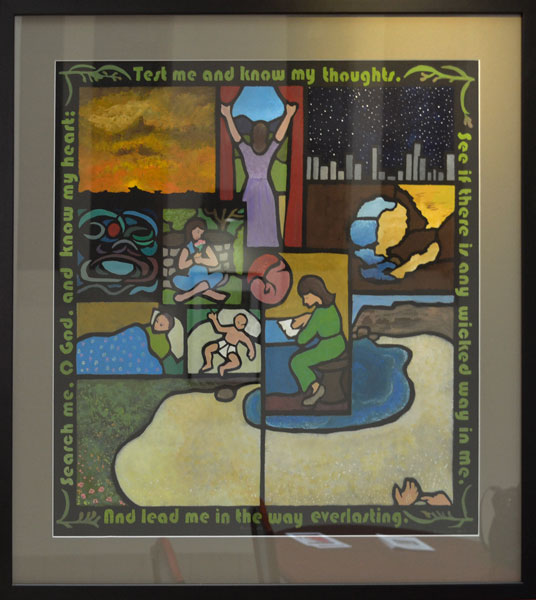
Psalm 139, Gouache stencil painting on black Stonehenge paper, 71cm x 71 cm
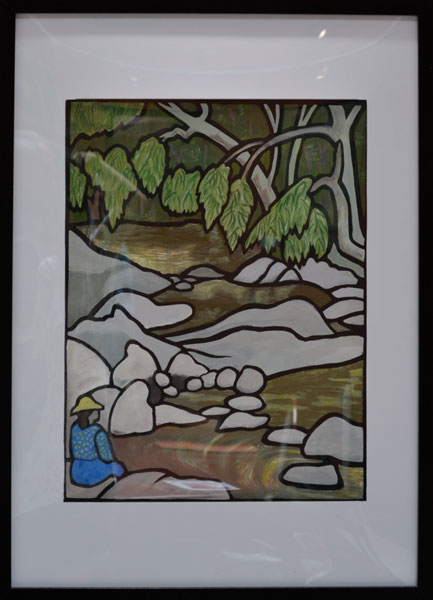
Where streams of living water flow (Psalm 145:2, a paraphrase of Psalm 23), Gouache stencil painting on black Stonehenge paper, 62cm x 44.5cm
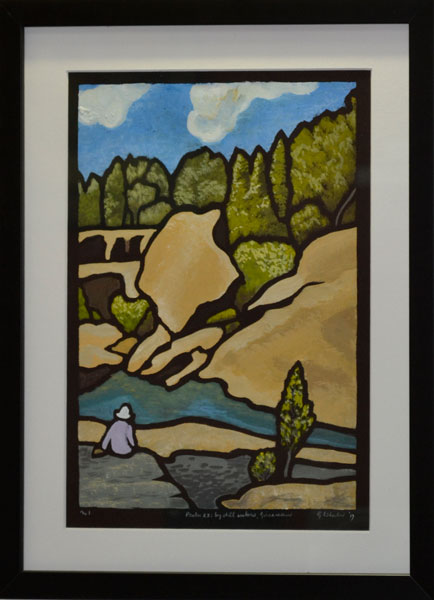
Psalm 23: He leads me beside still waters: Girraween, Gouache stencil painting on black Stonehenge paper, 40.7cm x 30.5cm
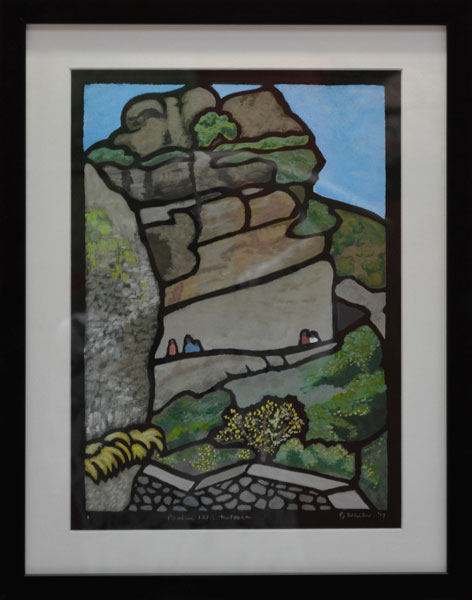
Psalm 121: I Lift my eyes to the hills: Meteroa, Gouache stencil painting on black Stonehenge paper, 40.7cm x 30.5cm

Acrylic, each 30cm x 30cm
From Left to Right top Row: Poplar Grove, Winter’s Peak, Radiant
From Left to Right Middle Row: Burst, Granite, Deep Water
From Left to Right Bottom Row: Sunset Gum, Ribbon Dance, October
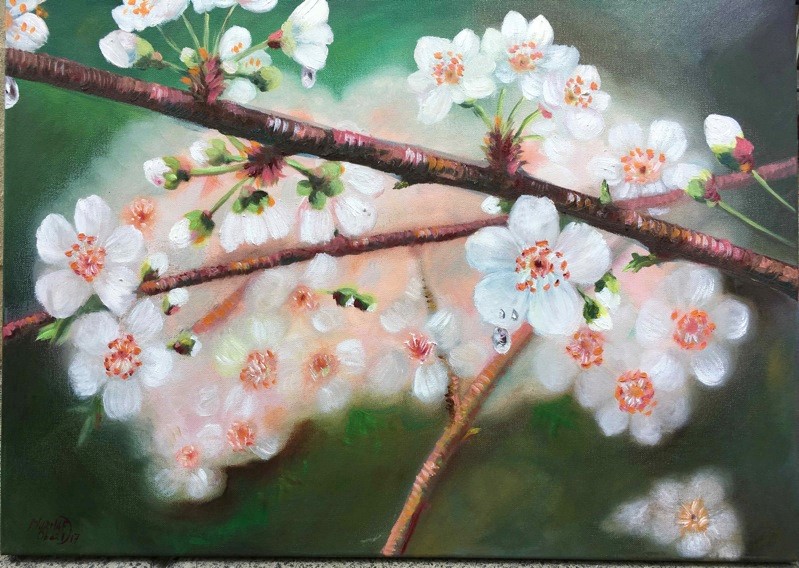
New Spring: Psalm 98:4, Oil on Canvas, 50cm x 70cm
Psalm 98:4 “Shout for joy to the Lord, all the earth, burst into jubilant song with music”.
The map of Australia, as a faded background, with the Syrian apricot blossom say that we came here, and we brought Life with us. As every human has the grace of God and the ability to give and create, and as the trees when the find fertile soil they yield abundantly, so we are in Australia as in a fertile soil.
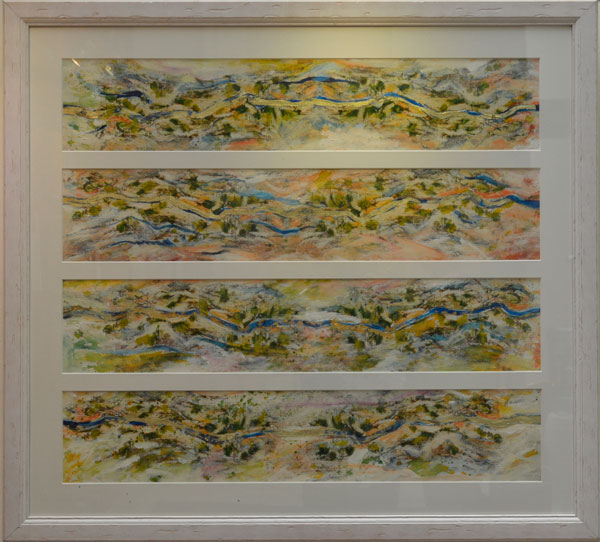
Psalm 107: 33-35, Oil on Canvas, 90cm x 100cm
Psalm 107
v33: He turned rivers in to desert, flowing springs into thirsty ground…
v35: He turned the desert into pools of water and parched ground into flowing springs.
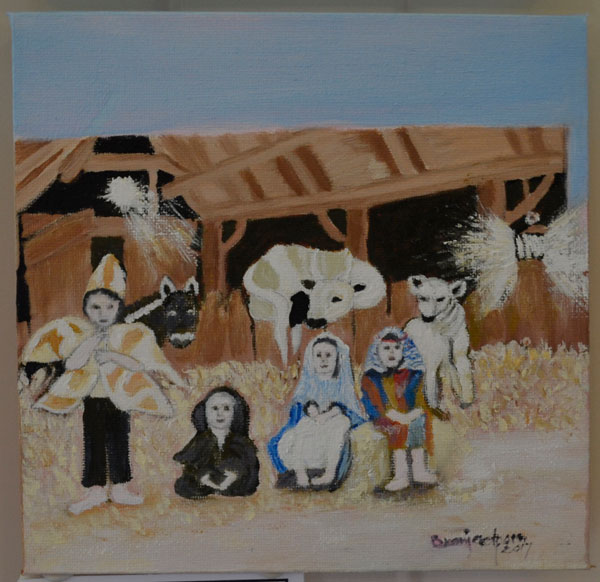
Christmas Advent Play: Gracie as the Star of Bethlehem, oil on canvas
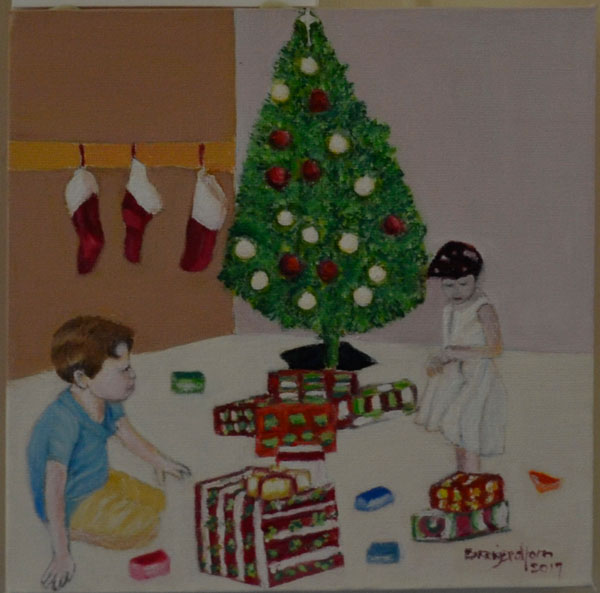
Christmas Morning with Gracie and Thomas, oil on canvas
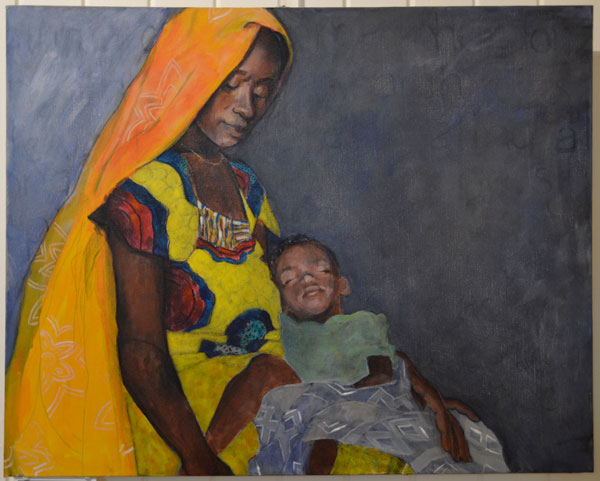
Safe, Pastel and acrylic on canvas, 61cm x 77cm
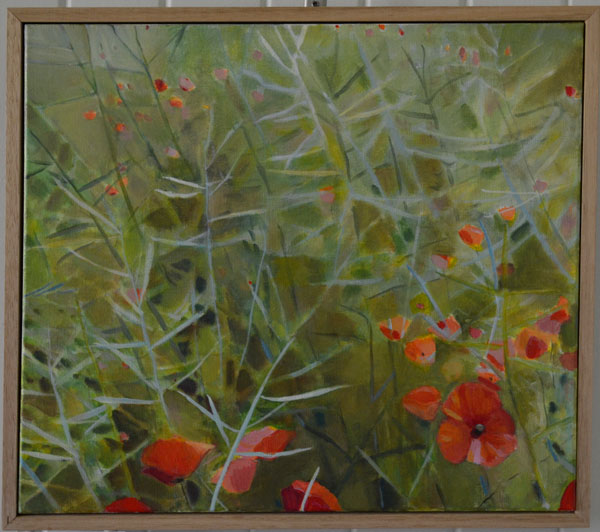
Untitled 2, acrylic on canvas, 44cm x 49cm
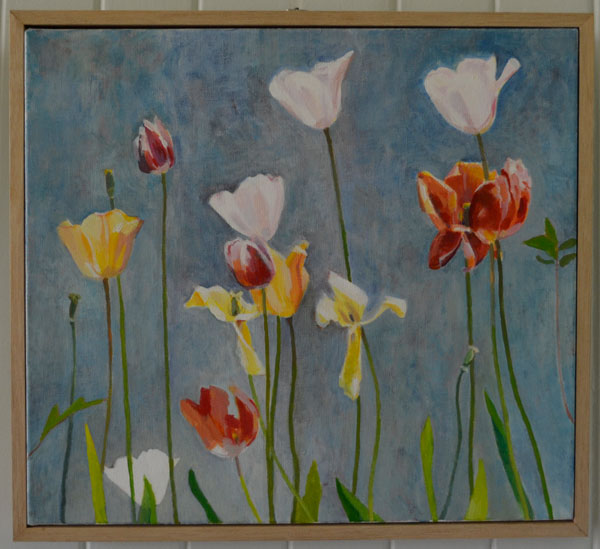
Untitled 3, acrylic on canvas, 44cm x 49cm
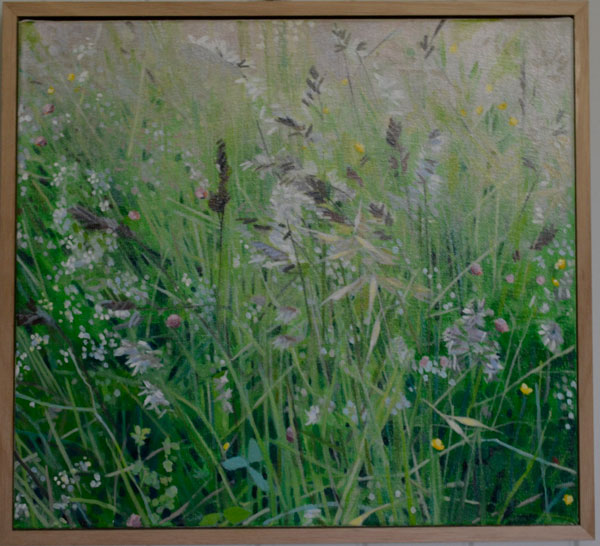
Untitled 4, acrylic on canvas, 44cm x 49cm
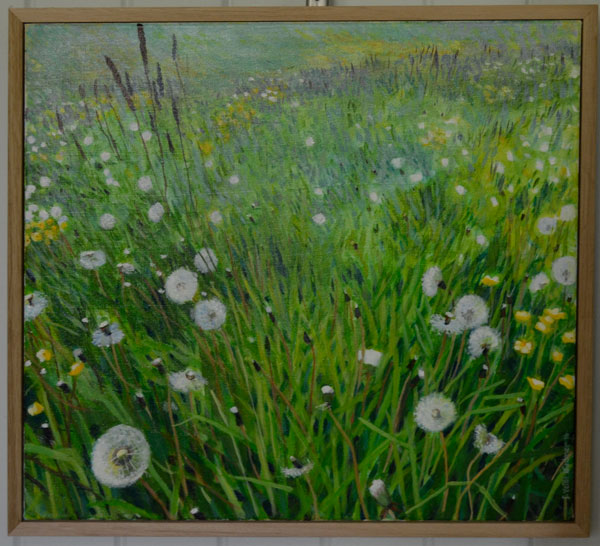
Untitled 5, acrylic on canvas, 44cm x 49cm